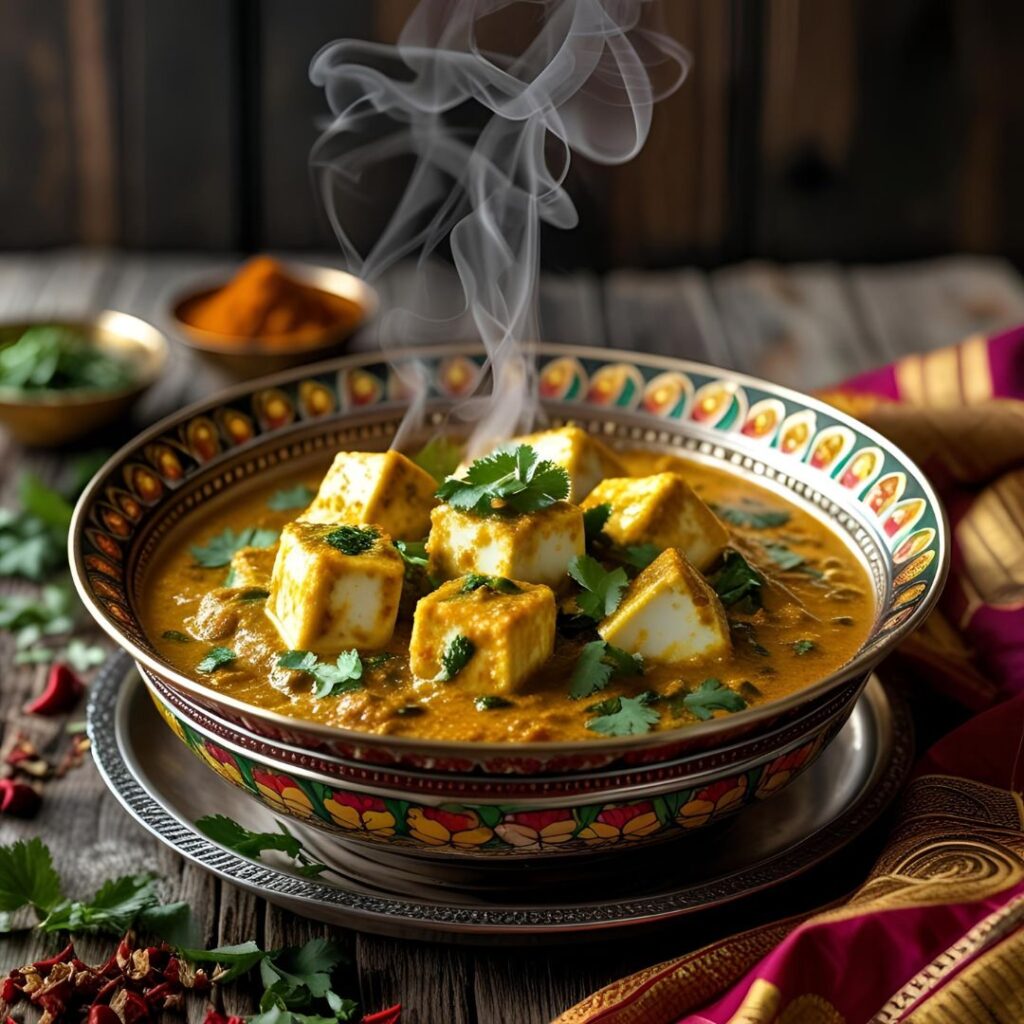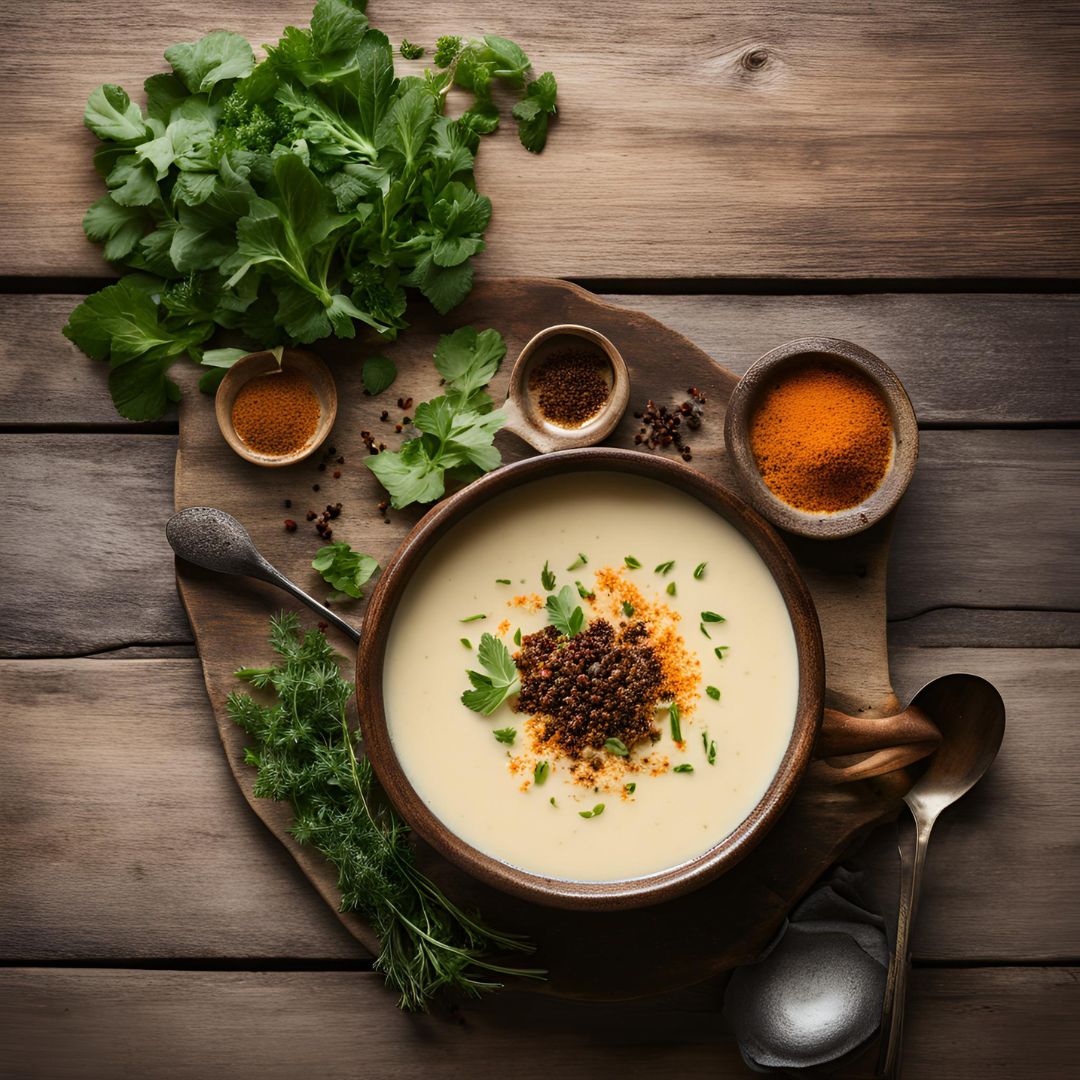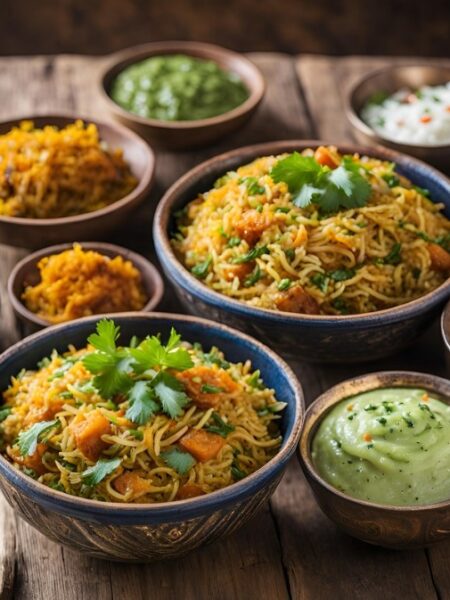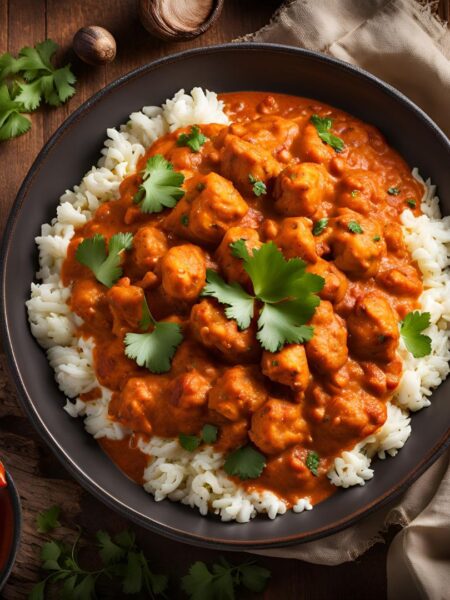Paneer Korma Recipe : A Royal Embrace of Flavor and Tradition. Paneer Korma is more than just a dish—it is a celebration of culinary finesse, heritage, and the subtle art of combining richness with restraint. Rooted deeply in the Mughal culinary tradition and evolving through centuries of regional interpretation, Paneer Korma has secured a proud place on the Indian table. This exquisite vegetarian delicacy offers a glimpse into India’s royal kitchens, blending creamy textures, fragrant spices, and the comforting familiarity of paneer to create something truly majestic.
The Mughal Legacy and Korma’s Origins
To understand Paneer Korma, one must begin with the word korma itself. Derived from the Urdu word qorma, which means “to braise” or “to cook gently,” korma originated in the royal Mughal courts. Traditionally, it involved meat cooked slowly in a sauce of yogurt, cream, nut pastes, and spices. The slow-cooked, opulent style of preparing food was synonymous with wealth, celebration, and sophistication—often served to emperors and nobles during grand banquets.
As the Mughal influence spread across northern India, the concept of korma underwent regional transformations. Over time, vegetarian variations became popular, especially in regions with large Hindu populations, where meat-free alternatives were favored. Among these, Paneer Korma stood out as a luxurious, yet accessible, vegetarian counterpart to its meaty predecessors.
Paneer: The Star Ingredient
Paneer, or Indian cottage cheese, plays a vital role in this dish. Mild in flavor, soft yet firm in texture, and rich in protein, paneer is a staple in many Indian households. Unlike Western cheeses, paneer does not melt, making it ideal for curries and gravies, where it can absorb the surrounding flavors without losing structure. In Paneer Korma, it serves as a delicate canvas that soaks up the creamy, spiced korma gravy, resulting in a harmonious blend of taste and texture.
What makes paneer especially beloved is its versatility. Whether grilled, fried, crumbled, or cubed, it holds its own in a wide variety of dishes, but it truly shines in rich gravies like korma. The silky sauce clings to each cube, making every bite a burst of creaminess and spice.
A Symphony of Flavors and Aromatics- Paneer Korma Recipe
What sets Paneer Korma apart from other paneer curries is its luxurious base. The gravy is often made from a combination of ground nuts—cashews or almonds—along with yogurt, fresh cream, and aromatic spices like cardamom, cloves, cinnamon, and bay leaves. This gives it a rich, velvety texture that feels indulgent without being heavy.
Unlike spicier counterparts like Kadai Paneer or Paneer Tikka Masala, Paneer Korma tends to be subtly spiced. The focus is on warmth rather than heat, with layers of flavor that unfold gently on the palate. Ingredients such as saffron, rose water, and kewra water are sometimes added to enhance the aroma, giving the dish a floral, royal touch.
The richness of the sauce is balanced with the tang of yogurt or a hint of tomato, depending on regional and personal preferences. It’s a dish where restraint is key—the spices are carefully measured, the textures balanced, and the overall flavor profile kept elegantly mellow.
Cultural and Regional Variations
While the classic North Indian style of Paneer Korma remains the most popular, there are numerous regional adaptations. In Hyderabad, a version of korma may include coconut and poppy seeds, adding a slight South Indian twist. In Kashmir, the use of dried fruits and saffron is more pronounced, giving the dish a sweeter, more aromatic profile. Paneer Korma might feature slightly more robust spices in Punjab, in line with the region’s bolder palate.
Whereas, In some Bengali kitchens, a hint of mustard oil or panch phoron (five-spice blend) might sneak in, giving it a local twist. These variations not only reflect regional tastes but also showcase how Indian cuisine thrives on adaptation and creativity.
A Vegetarian Choice with Regal Appeal – Paneer Korma Recipe
For vegetarians, Paneer Korma is a go-to option when seeking something indulgent, festive, or worthy of a special occasion. Whether served at weddings, festivals, or Sunday family lunches, it brings a sense of richness that matches any meat-based feast. It’s often considered a “showstopper” dish—one that elevates the meal and leaves a lasting impression.
Paneer Korma also holds a special place in religious and cultural celebrations where meat may be avoided. During Hindu festivals like Navratri, Janmashtami, or Diwali, it’s a common centerpiece that aligns with dietary restrictions while offering full-bodied satisfaction.
Pairing and Presentation
Paneer Korma is typically served with Indian breads like naan, kulcha, or lachha paratha, which are perfect for scooping up the rich gravy. It also pairs well with rice dishes such as jeera rice, saffron pulao, or plain steamed basmati. The neutral base of the bread or rice allows the nuanced flavors of the korma to shine.
Presentation-wise, a traditional serving of Paneer Korma might be garnished with silver leaf (varak), toasted nuts, or strands of saffron, especially in formal settings. These finishing touches are not just decorative but symbolic of the dish’s royal lineage.
A Modern Comfort Food – Paneer Korma
In contemporary Indian cuisine, Paneer Korma bridges the gap between old-world opulence and modern convenience. While the traditional recipe can be time-intensive, involving careful preparation of the gravy and slow cooking, today’s cooks often streamline the process with blenders, pressure cookers, or ready-made spice blends. Yet the core of the dish remains unchanged—a comforting, rich, and aromatic curry that feels like a warm embrace.
Moreover, the dish has found a global audience. Paneer Korma is now a popular offering in Indian restaurants worldwide, cherished by vegetarians and meat-eaters alike. Its mellow spice profile and creamy texture make it accessible to diverse palates, while its cultural depth continues to intrigue culinary enthusiasts.
Ingredients – Paneer Korma Recipe
For the Korma Gravy:
- 1 1/2 tbsp oil or ghee
- 1 large onion (sliced thin)
- 1-inch piece of ginger
- 4–5 garlic cloves
- 2 green chilies (optional)
- 10–12 cashews (soaked in warm water for 15–20 minutes)
- 2 medium tomatoes (chopped or pureed)
- 2 tbsp fresh yogurt (whisked, room temperature)
- 1/4 cup fresh cream
- 1 tbsp melon seeds (optional, or add extra cashews)
Spices:
- 1–2 green cardamoms
- 1-inch cinnamon stick
- 2 cloves
- 1 bay leaf
- 1/2 tsp cumin seeds
- 1/2 tsp coriander powder
- 1/2 tsp turmeric
- 1 tsp garam masala
- Salt to taste
- 1 tsp sugar (optional, for slight sweetness)
Main Ingredient:
- 250 grams paneer (cubed; homemade or store-bought)
Optional Garnish:
- 1 tsp kewra or rose water (for royal aroma)
- Chopped coriander or mint leaves
- Slivered almonds or fried onions
Cooking Instructions – Paneer Korma Recipe
1: Make the Base Paste
- Heat 1 tsp oil or ghee in a pan.
- Add sliced onions and sauté until golden brown.
- Cool slightly, then blend onions with soaked cashews, ginger, garlic, and green chilies into a smooth paste using a few tablespoons of water.
2: Prepare the Gravy
- Heat remaining oil or ghee in the same pan.
- Add whole spices: cumin, cinnamon, cardamom, cloves, and bay leaf.
- Add the onion-cashew paste and sauté for 4–5 minutes on medium heat until the oil separates slightly.
- Add tomato puree and cook until the mixture thickens and starts releasing oil.
3: Finish the Korma
- Lower the flame and add the whisked yogurt slowly, stirring continuously to prevent curdling.
- Add turmeric, coriander powder, salt, sugar, and mix well.
- Pour in cream and a splash of water or milk to adjust consistency.
- Simmer for 3–4 minutes until smooth and creamy.
- Add paneer cubes, garam masala, and rose/kewra water. Mix gently and simmer for 2–3 minutes more.
Time Breakdown
- Preparation Time: 15 minutes
- Cooking Time: 25 minutes
- Total Time: 40 minutes
Servings
- Serves: 3–4 people
Essential cooking tips – Paneer Korma Recipe
1. Use Fresh and Soft Paneer
The quality of paneer can make or break the dish. Always use fresh, soft paneer that’s not rubbery or overly firm. If you’re using store-bought paneer, soak it in warm water for 10–15 minutes before adding it to the gravy—this helps soften the cubes and improves their ability to absorb the flavors of the korma. Homemade paneer is ideal, as it tends to be softer and fresher. If you prefer a slightly firmer texture, lightly pan-fry the paneer cubes until golden before adding them to the curry. However, avoid over-frying, as it can make the paneer chewy.
2. Sauté the Onion-Cashew Paste Thoroughly
The base of Paneer Korma relies heavily on a rich, smooth paste typically made from onions, cashews (or almonds), garlic, and ginger. Once blended, it’s crucial to sauté this paste well until it turns aromatic and the raw smell disappears—usually 4–6 minutes. This process enhances depth of flavor and ensures the korma doesn’t taste flat or overly nutty. Don’t rush this step. You’ll notice a slight change in color and the oil starting to separate from the sides, indicating the paste has cooked properly. Insufficiently cooked paste can lead to a grainy texture and raw taste in the final dish.
3. Temper Yogurt Properly to Avoid Curdling
Yogurt adds richness and tang to Paneer Korma, but it must be added carefully to avoid curdling. Always use full-fat yogurt and ensure it is at room temperature. Before adding it to the hot pan, whisk it well to make it smooth. When incorporating yogurt into the dish, reduce the heat to low or remove the pan from heat briefly. Stir continuously while adding it slowly into the gravy. Sudden temperature changes can cause curdling, which will ruin the silky texture of your korma. For extra safety, you can mix a tablespoon of gram flour (besan) into the yogurt, which helps stabilize it during cooking.
4. Balance Spices for a Mild Yet Flavorful Taste
Paneer Korma is known for its subtle and balanced flavor—not too spicy, not too bland. Use whole spices like cardamom, cinnamon, and cloves to infuse aroma, and complement them with ground spices like turmeric, coriander powder, and garam masala. Avoid going heavy on red chili powder or other heat-inducing spices; instead, rely on aromatics and richness to drive flavor. If you enjoy a little sweetness, a pinch of sugar or a few raisins can be added to round out the dish. Always taste and adjust the seasoning at the end—this fine-tuning ensures your korma is full of layered, nuanced flavor.
5. Finish with Cream and Aromatics for Royal Touch
The final flourish in Paneer Korma is what gives it that truly “shahi” or royal feel. Adding a bit of fresh cream at the end not only enriches the texture but also balances the acidity from the yogurt and tomatoes. Additionally, a few drops of rose water or kewra water can elevate the aroma, giving your korma a fragrant, luxurious note reminiscent of Mughlai cuisine. Add these delicately—overdoing it can overpower the dish. A garnish of slivered almonds, chopped coriander, or fried onions can also add visual appeal and a touch of texture, completing the dish beautifully.
Important FAQs about the Paneer Korma Recipe
1. What is Paneer Korma?
Paneer Korma is a rich, creamy, and mildly spiced North Indian curry made with paneer (Indian cottage cheese) cooked in a gravy made of nuts, yogurt, cream, and aromatic spices. It draws its roots from Mughlai cuisine and is known for its luxurious texture and delicate flavor, making it a popular vegetarian alternative to meat-based kormas.
2. How is this recipe of Paneer Korma different from other paneer dishes?
Unlike spicier paneer dishes such as Paneer Tikka Masala or Kadai Paneer, Paneer Korma focuses on mild, aromatic flavors and a creamy texture. The use of ground nuts (like cashews or almonds), yogurt, and cream gives it a smooth and rich gravy. It’s less tangy and fiery, making it suitable for people who prefer subtle flavors over bold heat.
3. What kind of paneer should I use for this recipe of Paneer Korma?
For the best results, use fresh and soft paneer. Homemade paneer is ideal as it’s usually more tender and flavorful. If using store-bought paneer, soak it in warm water for 10–15 minutes before cooking to soften it. You can either use raw paneer cubes or lightly sauté them for a firmer texture—both work well depending on your preference.
4. Can I make recipe of Paneer Korma without nuts?
Yes, while cashews or almonds are traditionally used for creaminess, you can substitute them with alternatives like melon seeds or white poppy seeds if you have nut allergies. You can also increase the quantity of cream or yogurt slightly to maintain the richness, though the texture may vary slightly without the nuts.
5. How do I prevent the yogurt from curdling in the gravy in this Paneer Korma Recipe?
To avoid curdling, always use full-fat, room-temperature yogurt and whisk it well before adding it to the gravy. Lower the heat or briefly remove the pan from the stove when incorporating the yogurt. Stir continuously while adding it in small portions to help it blend smoothly with the rest of the sauce without splitting.
6. Is this recipe of Paneer Korma spicy?
No, Paneer Korma is traditionally not spicy. It’s flavored with whole spices like cardamom and cinnamon and is mildly seasoned with just a hint of green chili or chili powder. The focus is more on warmth and fragrance than on heat. However, you can adjust the spice level by adding more green chilies or red chili powder to suit your taste.
7. Can I make this recipe of Paneer Korma vegan?
Absolutely. To make a vegan version of Paneer Korma, replace paneer with firm tofu. Use plant-based yogurt (like almond or coconut yogurt) and cashew or coconut cream instead of dairy cream. Ensure all ingredients are dairy-free, and you’ll still get a rich, flavorful dish that closely mimics the original.
8. What can I serve with Paneer Korma made with this recipe?
Paneer Korma pairs wonderfully with a variety of Indian breads like naan, lachha paratha, or tandoori roti. It also goes well with basmati rice, jeera rice, or a light pulao. Because the dish is rich and mildly flavored, it complements well with simple sides like cucumber salad, pickled onions, or papad.
9. How can I store and reheat leftovers of Paneer Korma made with this recipe?
Paneer Korma can be stored in an airtight container in the refrigerator for up to 2–3 days. To reheat, use a pan on low heat and add a splash of milk or water to loosen the gravy if it has thickened. Avoid microwaving for long periods, as that may make the paneer rubbery. Gently reheat until just warm to retain its creamy texture.
10. Can I prepare Paneer Korma in advance for parties or festivals?
Yes, Paneer Korma is a great make-ahead dish. You can prepare the gravy a day in advance and store it in the fridge. On the day of serving, just heat the gravy and add paneer cubes shortly before serving to keep them soft. This method saves time and helps the flavors develop even more overnight.
Paneer Korma Recipe
Rooted deeply in the Mughal culinary tradition and evolving through centuries of regional interpretation, Paneer Korma has secured a proud place on the Indian table. This exquisite vegetarian delicacy offers a glimpse into India’s royal kitchens, blending creamy textures, fragrant spices, and the comforting familiarity of paneer to create something truly majestic.

Ingredients - Paneer Korma Recipe
For the Korma Gravy:
Spices:
Main Ingredient:
Optional Garnish:
Cooking Instructions - Paneer Korma Recipe
Step 1: Make the Base Paste
- • Heat 1 tsp oil or ghee in a pan.
- • Add sliced onions and sauté until golden brown.
- • Cool slightly, then blend onions with soaked cashews, ginger, garlic, and green chilies into a smooth paste using a few tablespoons of water.
Step 2: Prepare the Gravy
- • Heat remaining oil or ghee in the same pan.
- • Add whole spices: cumin, cinnamon, cardamom, cloves, and bay leaf.
- • Add the onion-cashew paste and sauté for 4–5 minutes on medium heat until the oil separates slightly.
- • Add tomato puree and cook until the mixture thickens and starts releasing oil.
Step 3: Finish the Korma
- • Lower the flame and add the whisked yogurt slowly, stirring continuously to prevent curdling.
- • Add turmeric, coriander powder, salt, sugar, and mix well.
- • Pour in cream and a splash of water or milk to adjust consistency.
- • Simmer for 3–4 minutes until smooth and creamy.
- • Add paneer cubes, garam masala, and rose/kewra water. Mix gently and simmer for 2–3 minutes more.





